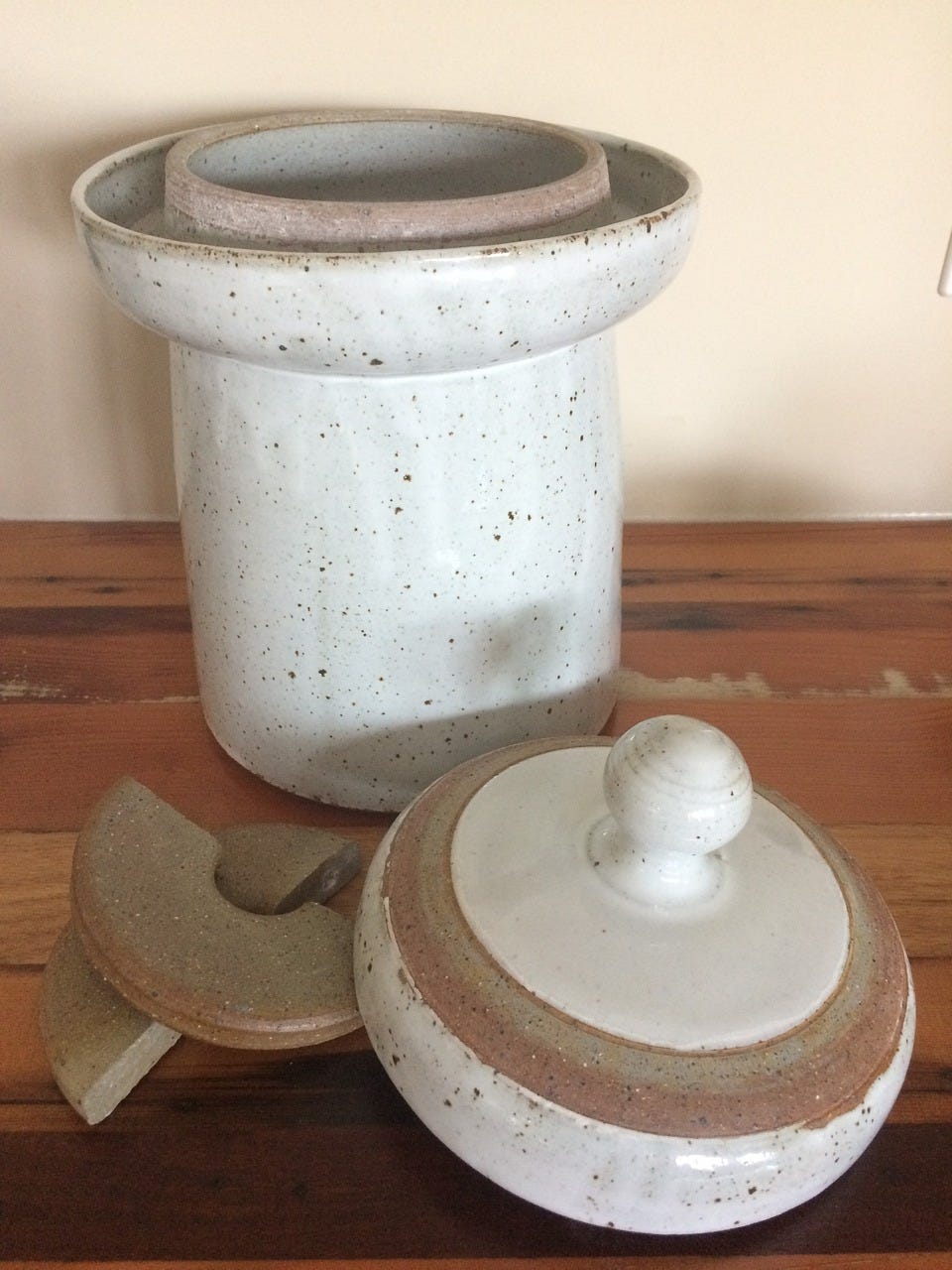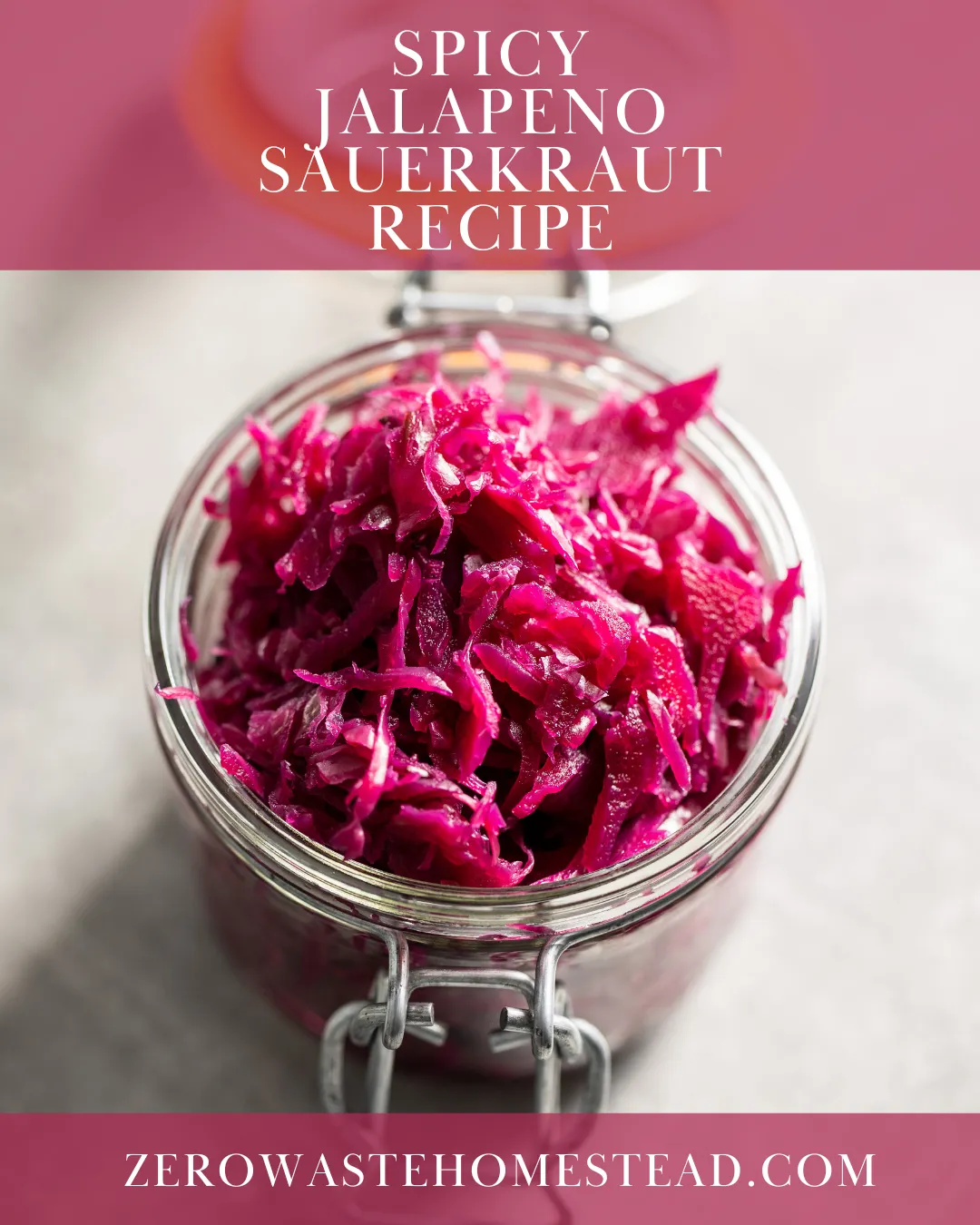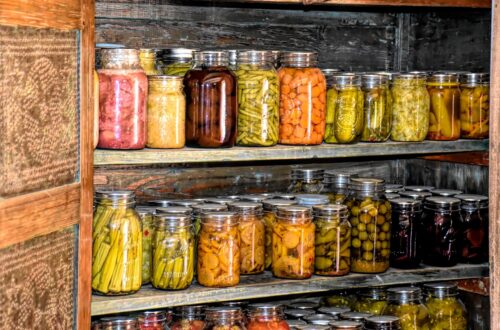Love heat? Spice up your homemade sauerkraut with fiery jalapenos!
Traditional German sauerkraut is a must-have topping for bratwurst and hot dogs. But if you crave spicy heat and unique flavor, you may want to make fiery lacto-fermented sauerkraut instead.
In the guide below, you’ll find beginner-friendly fermentation tips and easy to follow steps for making zesty, homemade sauerkraut. It’s the perfect complement for Buddha bowls and more!
Affiliate disclosure: As an Amazon Associate, I may earn commissions from qualifying purchases.

What is Lacto-Fermentation?
Lacto-fermentation is a food preservation technique that takes advantage of the “good guy” bacteria (Lactobacillus) that naturally exist in the environment. When these bacteria get to work on fermented foods, they convert the sugar and starches in vegetables into lactic acid. This naturally helps to preserve the texture, color and taste of fermented veggies.
Traditional sauerkraut is made with lacto-fermentation… but so are deli pickles, kimchi and other fermented goodies. Fermenting is not the same as canning or pickling, although fermented foods can be processed with water bath canning for a longer shelf life. Pickled foods are typically preserved with vinegar, while true ferments or cultured foods are preserved in a saltwater brine.

How to Make Spicy Sauerkraut in a Crock
If you prefer traditional flavors, I have a full guide on creating German-style sauerkraut. However, if you have a taste for adventure, the recipe below will make a tasty and spicy sauerkraut with turmeric, ginger and jalapenos!
What you’ll need:
- 1 head of cabbage (either red or green)
- 1 tablespoon of Himalayan salt or sea salt
- 1 to 2″ of fresh ginger root, grated or finely chopped
- 2 teaspoons of fresh turmeric, grated or finely chopped
- 1/2 teaspoon of ground black pepper
- 4 to 6 cloves of garlic, finely chopped
- 1 to 2 jalapenos (depending on how much heat you want), finely chopped
- 1-gallon canning jar or fermentation crock
- Cutting board
- Knife
- Sauerkraut pounder
- Canning weights
- Metal sheet pan or large plate

The process:
Step 1: Slice the cabbage.
Wash the cabbage head, then remove the outermost cabbage leaf and put the leaf to the side for now. Cut the rest of the cabbage into quarters, remove the core and thinly slice the cabbage into 1/4″ wide ribbons.
Step 2: Add salt.
Add the cabbage to a large mixing bowl, stir in the salt and mix until the cabbage is evenly coated. Allow the cabbage to marinate in the salt for at least 15 minutes. This will help the cabbage leaves release some water and become more pliable.

Step 3: Pound the cabbage.
Using a sauerkraut pounder or other heavy, food-safe item, pound the cabbage for 8 to 10 minutes. This takes a bit of elbow grease, so I like to put on some music while I work!
Once you’re done, you’ll be left with nice, soft cabbage ribbons and lots of salty liquid. That liquid is your sauerkraut brine, so don’t throw it out!

Step 4: Add the spices.
Add the ginger, turmeric, jalapenos, garlic and black pepper to the cabbage and mix everything together well.

Step 5: Fill up the fermentation crop.
Start packing the cabbage mixture into a clean fermentation crock or jar, taking the time to press out any air bubbles as you work. Next, lightly layer that cabbage leaf you saved over the top of your cabbage and weigh it down with fermentation weights. This will keep small pieces of cabbage from bubbling to the surface later on.
Once the crock is filled, pour in the sauerkraut brine. The brine should completely cover the cabbage. If you need more brine, mix 1 tablespoon of salt in 4 cups of non-chlorinated water. Make sure you don’t skimp on the brine…any cabbage pieces that are exposed to air will likely develop mold!

Step 6: Ferment!
Cover the crock with cheesecloth or a kitchen towel secured with a rubber band, or loosely place a lid on top of the container. Make sure the lid isn’t screwed on tightly as the fermentation process creates gasses that can sometimes make fermentation crocks explode! If your fermentation crock has an airlock, the airlock will naturally let air move out of your jar during fermentation.
Place the fermentation crock onto a large plate or baking sheet (to catch any liquid that bubbles out) and move it into a warm, dark place… like under a kitchen cabinet. Allow the cabbage to ferment for 7 to 14 days.
After a week has passed, sample your sauerkraut. If it tastes good, move the jar into your fridge to stop the fermentation process. If you want a tangier ferment, allow the cabbage to ferment for another week.

How Do Your Store Sauerkraut?
When stored in the fridge, fermented cabbage sauerkraut will stay fresh for about 4 to 6 months. For longer term storage, you can also process sauerkraut with water bath canning, although this will kill the beneficial probiotics in your ‘kraut. It will still taste good though!

What Other Foods Can You Ferment?
Cabbage is one of the most common vegetables that’s preserved with lacto-fermentation. However, other crops from your vegetable garden can also be fermented. This is a great way to preserve your harvest and prevent food waste.
If you love making sauerkraut and want to experiment with other fermentation possibilities, try fermenting:
- Carrots
- Daikon radishes and other radishes
- Cucumbers (pickles anyone?)
- Snap beans
- Beets
- Cauliflower
- Peppers
- Onions
- Garlic

Frequently Asked Questions About Homemade Sauerkraut
What kind of salt is best for sauerkraut?
Himalayan salt or sea salt are the best types of salt for fermentation. Iodized or table salt are not recommended for fermented foods as these salts often contain additives that can affect the fermentation process.
Can you use pink Himalayan salt to make sauerkraut?
Yes you can! Pink Himalayan salt is one of the best salts for lacto-fermentation!
What can I add to sauerkraut to make it taste better?
Traditional sauerkraut often utilizes juniper berries and/or caraway seeds. For even more flavor, consider mixing shredded apples or carrots into your ferment.





